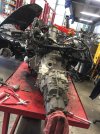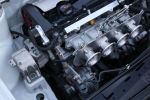That certainly can be done, but with sacrifices to drivability and torque; it's going to take a lot of cam to take an engine that naturally wants to make probably 130-140HP and force it to make 200. I'm not saying that it can't be done. People did it with the 16V engines back in olden times. But 200HP NA on a 20V 1.8L is a bragging rights thing, not a practical decision. Turbochargers make engines more powerful and quieter while retaining tame cam profiles, making them more efficient. And the torque--let's not forget the torque. There is no way to cam your way into the torque that a turbocharger would give you. Did he at least bore and stroke to 2L, or did he further put himself behind the 8 ball by keeping it at 1.8L?
I built a 2L 8V NA engine that made probably 160HP. It was a conventional counterflow head that was professionally ported and had a custom ground camshaft (300/284, .490/.460) with a header and an exhaust system that was optimized to the best of my ability without building my own header, which was beyond my ability at that time. It probably would have made more power if it weren't breathing through a KE Jetronic metering plate. But the sacrifice of drivability was real. It idled OK enough, but it was logy at tip-in off idle and wasn't much fun until about 4KRPM--all for 150-160HP. Of course, less cam would have been required on a 16V engine, but I wanted the (inverse) prestige of sticking with the 8V engine.
Fast forward a few years from that engine, and I was building 8V turbo engines for customers. These were mostly mild engines that made more power and torque than that wild NA engine on stock camshafts with just 10PSI of boost--one even with a purely stock engine except for the upgrade to head studs and a MLS head gasket. That lumpy 300 degree street engine was fun in its own way, but it wasn't as fast, made too much noise, and got 17MPG in combined driving.




